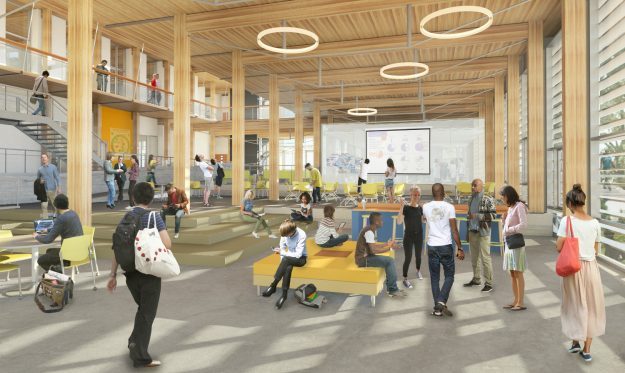This is the first article in a Living Building Chronicle series this week on the Energy Petal for the Kendeda Building for Innovative Sustainable Design.
Espresso was too much to ask.
The Living Building at Georgia Tech already had been spitting out energy challenges that members of its experienced design team hadn’t faced before. To meet the Living Building Challenge standard, the project must generate at least 5 percent more power than it uses. And it has to do that in a humid climate that complicates the air conditioning.
That’s compounded by the building’s complexity. Unlike many other net positive structures — from event spaces to elementary schools — this one will be occupied 12 months a year, up to 18 hours per day. Its uses also will vary: Seven classrooms of various sizes. Study areas. Offices. A 170-seat auditorium. Even a “maker space” where students will pursue creative, sustainably oriented projects.
Those multiple uses mean exterior doors will open and close with regularity. Some sections of the building will be packed with active people; others will be more sedate and less crowded. And the energy models must account for the need to power everything from air conditioning and heat to an elevator, computers and recharging cellphones.

Then, the idea of adding a coffee cart was introduced to the equation. Many Georgia Tech buildings serve coffee to a community that never seems to sleep. If this building doesn’t have joe, members of the design team reasoned, it may not be as popular as the others. And a building that’s not loved — well, that cuts against part of the mission of a Living Building: to create a useful, practical and replicable model of a building that does more to heal the planet than to harm it.
So PAE Engineers’ Marc Brune, the lead mechanical engineer on the project, set his team to work on analyzing the amount of energy it would take to brew different types of coffee. Would steaming cappuccinos eat up too much electricity? What about simply brewing hot coffee? Or would students at the Living Building be relegated only to cold brew?
It was the kind of deep analysis that characterizes a building with little room for error when it comes to energy. Designers hope the Living Building at Georgia Tech will clear a path for similar buildings across the Southeast and, for that matter, in hot-humid climates around the world. So getting every detail right in the energy equation is particularly important.
Design team members finally recommended a coffee kiosk. It could serve hot coffee, they reasoned. But espresso and cappuccino, which requires steamed milk, would gobble up too much energy.
This level of scrutiny may sound complicated. But the Energy Petal of Living Building Challenge 3.1 is fairly simple. Aside from a requirement for onsite power storage, it contains a single imperative: “One hundred and five percent of the project’s energy needs must be supplied by on-site renewable energy on a net annual basis, without the use of on-site combustion.”

Sometimes, though, a difficult destination can only be reached by a circuitous path. Theoretically, an owner could provide all the energy a building might require by installing more and better solar panels.
“But the most cost-effective way for us to get to net positive is by reducing the amount of energy the building needs,” notes John McFarland, a vice president at WorkingBuildings and the Kendeda Fund’s liaison to the building’s design team.
It’s not surprising then that the building’s energy X-factors have fallen mainly on the demand side of the equation. There’s no single formula that engineers can use to provide highly efficient heating, cooling, dehumidification, ventilation, lighting and “plug loads” in a complex building that serves a variety of active purposes in a challenging climate. The LBC’s stringent imperatives regarding the materials, water, health, beauty and equity don’t make the task any easier.
“Just the requirement to be net positive is profound,” says Greg Spiro, senior mechanical engineer for design and construction at Georgia Tech. “Without being able to use combustion, you have to heat the building and the water, and cool it, too. So, from an engineering standpoint, that pushes you into interesting directions.”
Part 2: A brief history lesson reveals how net zero buildings finally became feasible.



Talk about detail oriented– I love it!